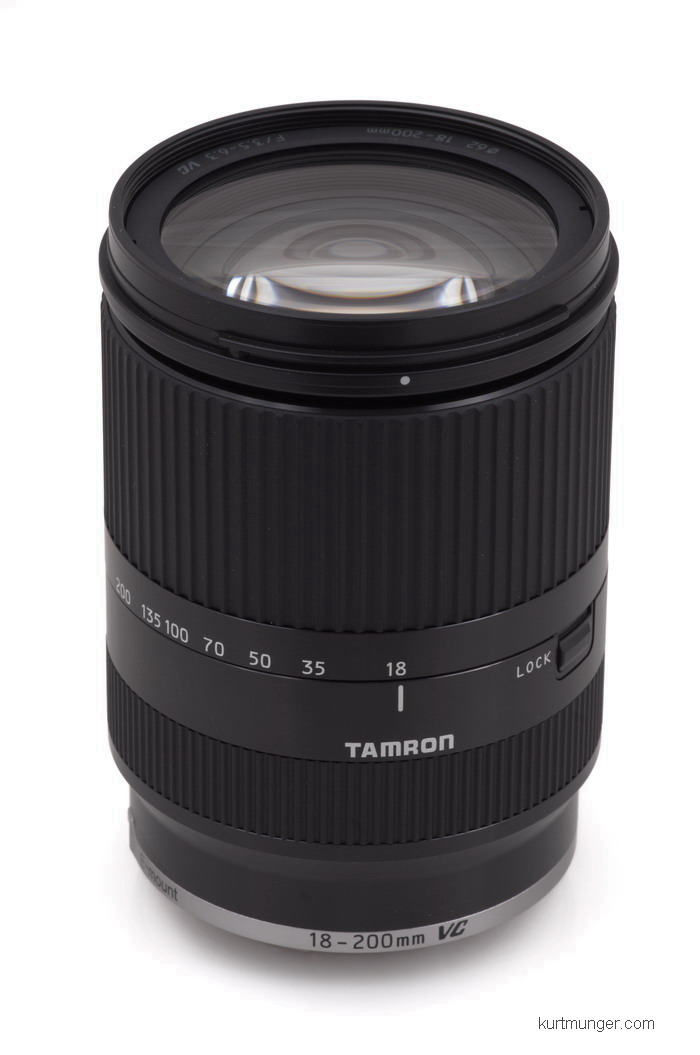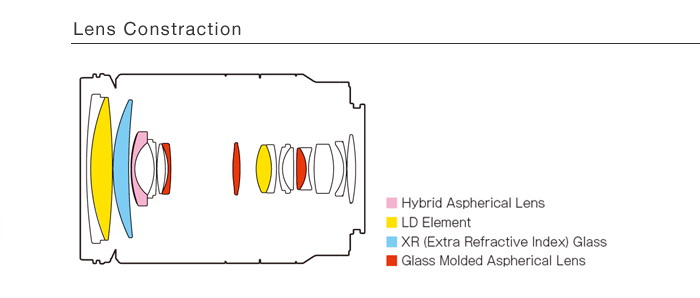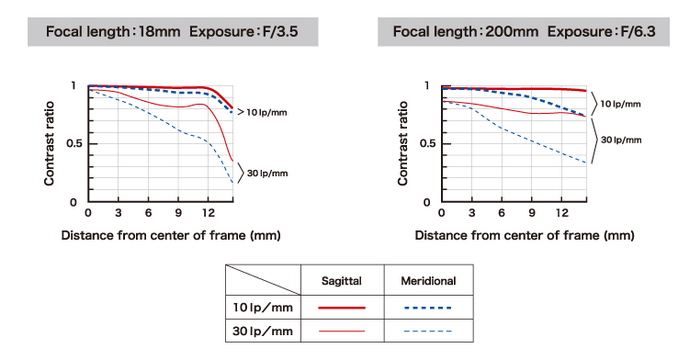Here’s a brief look at the Tamron NEX 18-200mm F/3.5-6.3 zoom lens. Scroll down for the main review.
|
Lens
|
|
|
Box contents
|
Hood, front and rear caps and a user’s manual.
|
|
Cost
|
$739 retail as of 2/12
|
|
Build quality
|
Good to very good.
|
|
Additional information
|
Introduced in late 2011. Has built-in optical image stabilization or VC (vibration control), and a quiet focus motor inside.
|
Specifications below
|
|
|
Optical configuration
|
17 elements in 13 groups
|
|
Angle of view
|
75°-8° APS-C
|
|
Aperture
|
7 blades, curved
|
|
Full frame and APS-C
|
APS-C only, and will only mount on E body cameras. With crop factor of 1.5x the coverage equals 27-300mm.
|
|
Depth of field and focus scales?
|
Nothing.
|
|
Min. focus distance, image plane to subject @ max reproduction ratio
|
About 19.9″ (505mm)
|
|
Min. focus distance, end of lens barrel to subject @ max. reproduction ratio
|
About 12.4″ (315mm)
|
|
Hard stop at infinity focus?
|
No
|
|
Length changes when focusing?
|
No
|
|
Focus ring turns in AF?
|
No
|
|
Filter size
|
62mm
|
|
Filter ring rotates?
|
No
|
|
Distance encoder?
|
Yes
|
|
Max magnification
|
0.27x, or 1:3.7
|
|
Min. F/stop
|
F/22-40
|
|
Sony teleconverter compatible?
|
No
|
|
Length changes when zooming?
|
Yes
|
|
Dimensions WxL (my measurements)
|
2.7″ x 3.8″ 68mm x 97mm.
|
|
Maximum extended length (my measurements)
|
6.7″ (171mm)
|
|
Weight bare (my scale)
|
16oz (459g)
|
Requisite product shots.
 |
| Box and contents |
 |
| Side shot |
 |
| Backside mount. Notice lens bottom scuff pad above the ‘B011’ sticker |
 |
| Fully extended |
 |
| X-ray view |
 |
| MTF chart |
The Sony NEX-7 was used for this review.
For a better understanding of terms and methods used in this review, go here. Check out the image sharpness crops at the bottom of the page.
The Tamron NEX 18-200mm F/3.5-6.3 is the first fully functional aftermarket lens to be offered for a Sony NEX camera, with more to follow in the coming months and years.
The Tamron (for NEX) 18-200mm F/3.5-6.3 (Made in Japan) is build solidly, has a relatively smooth zoom and manual focus action, along with a nearly silent auto-focus motor which is great for keeping focus noise out of movies. You’ll also notice the VC or vibration control built into the lens, that’s Tarmon’s version of Sony’s ‘SteadyShot’. In-lens image stabilization is important as NEX camera bodies do not have sensor shift stabilization like the DSLRs and SLTs have. Tamron claims the use of seven special lens elements inside, see the second to last product shot above.
Fit and finish are very good. The lens appears to be clad in a mixture of metal and plastic, most notably a two-piece plastic extension tube, and a metal mount. Focus and zoom rings have a black rubber ribbed design. This lens sports a zoom lock switch (only at 18mm), and a black scuff pad on the underside, seen in the product shot above. This lens comes in two colors, silver or black, and match closely with the NEX camera body colors.
The zoom action is smooth and damped properly in my opinion, and holds its position well, so there is no zoom creep unless you like to run with the camera with the lens pointed downward. If you should encounter zoom creep, simply use the zoom lock button, which works only at the 18mm position. Focal length index marks come at 18mm, 35mm, 50mm, 70mm, 100mm, 135mm, and 200mm. The EXIF data doesn’t always match those lengths exactly, there may be a 1 or 2mm difference, this is no big deal, I’m just pointing it out.
In the box: the lens, front and rear caps, a plastic petal hood, and owner’s manual.
Focusing. This lens auto-focuses almost silently, about the same as a Sony NEX lens. At the wide end, focusing is generally quite good, although it will completely miss occasionally, but that’s a camera issue, and will happen with all NEX lenses. Focusing on the long end is good, but not great, sometimes there’s a problem locking focus on low contrast subjects, and especially in low-light. The Tamron seems to focus quicker on close subjects than the Sony NEX 18-200mm tested here too. The front filter ring doesn’t turn when focusing, so your polarizers and grads will work great. The VC or ‘vibration control’ seems to work well, and slightly better than the SSS or super Steadyshot on Sony DSLRs and SLTs. For a closer look at sensor-shift image stabilization and inside the lens stabilization, go here. Lens flare/ghosting. Above average control for a super-zoom by today’s standards. See examples below.
Color fringing (CA). Below average control at both ends, where you’ll see plenty of red and cyan along the sides of the image, at all apertures; however, some NEX cameras will automatically eliminate this. See examples below.
Bokeh. Mostly harsh at all focal lengths. Look below for sample crops.
Color. Same as other Sony lenses.
Close up filter. N/A
Coma. None.
Regular filters cause almost no additional light fall-off when the aperture is fully open at either end of the zoom.
Filter size is 62mm. Other Sony lenses that use 62mm filters are; 70-300mm G, CZ 16-80mm, 16-105mm, 24-105mm, 18-250mm, and the 18-200mm.
Distortion. You’ll notice strong barrel distortion at 18mm, becoming relatively flat around 24mm, then turning to moderate pincushion distortion at 50mm. The pincushion doesn’t seem to get any worse as you zoom to 200mm. Close focus through infinity focus seems to show about the same amount of distortion at the same focal length. Check out the cropped samples below.
Distortion examples directly below.
 |
| 18mm, strong barrel distortion |
 |
| 31mm, still wavy, but flatter |
 |
| 200mm, moderate pincushion distortion. |
Distortion is strong at 18mm, but flattens out around 24mm, although it always stays a little wavy, even when corrected in-camera (on select NEX cameras). Pincushion starts around 50mm, but the signature is fairly simple and easy to fix with distortion sliders.
Light fall-off.
|
18mm F/3.5
|
18mm F/5.6
|
|
|
|
|
200mm F/6.3
|
200mm F/8
|
|
|
|
Light fall-off is moderate at the wide end when the aperture is fully open, but not very noticeable in real pictures. Some NEX cameras will automatically remove the dark corners; it’s called ‘shading’ in the settings menu under lens comps.
Aperture/focal length guide.
|
Maximum aperture
|
F/3.5
|
F/4
|
F/4.5
|
F/5
|
F/5.6
|
F/6.3
|
|
Range
|
18-23mm
|
23-31mm
|
31-39mm
|
39-47mm
|
47-74mm
|
74-200mm
|
Focal length numbers carry through between apertures, which is normal. You may get slightly different numbers if you want to spend all day firing off shots and moving the zoom ring in tiny increments. I didn’t want to do that.
Bokeh crops next.
|
18mm F/3.5
|
18mm F/5.6
|
|
|
|
|
200mm F/6.3
|
200mm F/8
|
|
|
|
Bokeh is harsh at both ends when the subject and background are close together, but bokeh becomes smooth if you focus on something close and the background is far away; that’s normal though. Crops are from the center of the image, about 10′ to 20′ (3m-6m) behind the focus point.
Flare and ghosting.
|
18mm F/5.6 sun low in sky
|
18mm F/5.6 sun higher in sky
|
|
|
|
|
52mm F/5.6
|
200mm F/6.3
|
|
|
|
Overall, the Tamron 18-200mm NEX does a good job at reducing flare and ghosting. When the sun is low in the sky, I see little or no ghosts at the wide end. When the sun is higher in the sky, you’ll see some blobs in a line to the sun. At the long end, you’ll see mostly flare, which covers most of the image, although that’s typical of zooms like this.
Let’s check out the close focus capabilities of this lens.
Check out the 100% cropped portion of the full image. The sample shot was taken with the NEX-7 24mp camera, so don’t compare it to others that were taken with 12-16mp cameras. The subject is a standard US stamp, 0.87″x 1.0″ or 22mm x 25mm. Also, note the shot was taken as close to the subject as focusing allowed; in this case a somewhat short 12.4″ (315mm), measured from the front of the lens barrel to the subject.
This lens has a fairly large reproduction size of 0.27x, and it produced a pretty sharp close focus shot at F/8, although F/6.3 was almost as good; using F/11 shows a slightly softer image due to diffraction. As a side note; the “1996” on the bottom left of the stamp measures a mere 1mm wide.
 |
| As close as you can get. F/8. click for larger image |
Now for the conclusion.
The Tamron (for NEX) 18-200mm F/3.5-6.3 VC Di III lens is fairly expensive, but provides image stabilization, super quiet focusing, and a very useful focal range, but so does the Sony version, so which one is best?
The optical performance between the Sony and Tamron 18-200mm lenses is quite similar, however, there are differences such as; the Tamron has better ghosting control, and is sharper in the centers near the long end, especially up close, (see the stamp shot). Additionally, the Tamron uses 62mm filters, which Sony uses on many of their ‘a’ mount lenses, and you might already have one or two. The Sony NEX 18-200mm uses 67mm, which is uncommon for Sony. Buying a couple of 67mm filters could cost you more than $100. Size and feel; the Tamron 18-200mm is a little slimmer and lighter, that’s important if you’re looking for the smallest package for carrying around regularly. Build quality is a toss-up between the two.
Pluses for the Tamron 18-200mm F/3.5-6.3; very good optical performance between 18mm-50mm across the entire frame, VC or vibration control works well, fairly quick and accurate focusing, good ghosting control, and good center sharpness at longer focal lengths. The Tamron 18-200mm sharpness is optimized at F/5.6-6.3, so you don’t need to stop down hard to get sharp results.
Negatives; strong distortion from 18-22mm, but is correctable in-camera if you have this feature, soft sides at longer focal lengths, unfortunately, stopping down doesn’t help.
Bottom line; if you only want one lens to use on your NEX camera, the Tarmon 18-200mm is plenty good, and generally equal to the Sony version for significantly less money.
As of this review, the sweep panorama mode will not work properly with the Tamron lens, in fact, it’s pretty much useless, so if that’s one of your favorite features, you might want to hold off getting this lens until a fix is issued by Tamron.
|




















































